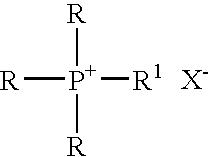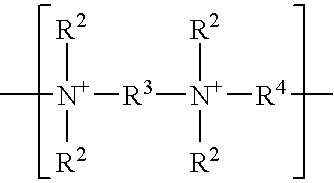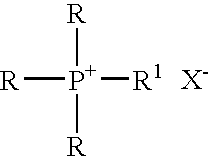Biocidal compositions
- Summary
- Abstract
- Description
- Claims
- Application Information
AI Technical Summary
Benefits of technology
Problems solved by technology
Method used
Image
Examples
example 1
[0268]A suspension of Pseudomonas aeruginosa bacteria containing from 3-5×106 cells / mL was prepared in pH 8.5 phosphate buffer. Aliquots of this suspension were dosed with the indicated concentrations of the different compositions with the concentrations being measured as ppm by weight of the stated composition in the dosed suspension. At the designated contact times, each aliquot was sampled to determine the total number of viable organisms in colony forming units per milliliter (CFU / mL) on plate count agar. An endpoint of 1 or 4 log10 reduction in viable organisms was then selected for calculating synergy.
[0269]The following formulations (compositions C and D) according to the invention were prepared from:
[0270]Bellacide 350 (an aqueous composition of tri n-butyl n-tetradecyl phosphonium chloride (hereafter “TTPC”) and water consisting of water and 50% by weight of TTPC) (composition A);
[0271]WSCP (an aqueous composition of poly[oxyethylene(dimethyliminio)ethylene(dimethyliminio)e...
example 2
[0293]A suspension of Pseudomonas aeruginosa bacteria was prepared, dosed and sampled as described in Example 1. An endpoint of 1 or 4 log10 reduction in viable organisms was selected for calculating synergy.
[0294]The following formulations (products E to H) according to the invention were prepared from: Bellacide 350 (an aqueous composition of tri n-butyl n-tetradecyl phosphonium chloride (hereafter “TTPC”) and water consisting of water and 50% by weight of TTPC) (composition A);
[0295]WSCP (an aqueous composition of poly[oxyethylene(dimethyliminio)ethylene(dimethyliminio)ethylene dichloride] (hereafter “poyquat”) and water consisting of water and 60% by weight of polyquat) (composition B);
[0296]a hydrotrope composition consisting of an aqueous mixture of water and 70% by weight of alkyl iminodiopropionate amphoteric surfactant.; and
[0297]water.
Composition E (ratio A:B=4:1)
[0298]4 parts by weight composition A
[0299]1 part by weight composition B
[0300]1.82 parts by weight hydrotrope ...
example 3
[0338]A suspension of Chlorella vulgaris algae that had an absorbance of 0.5 at 450 nm was prepared in pH 8.5 Allen's media. This gives the appropriate number of algae cells per millilitre for the biocide challenge test. One hundred and fifty microliters of this suspension was placed into each well of a 96 well tissue culture plate. The first well in each row was dosed with the desired amount of the indicated product and the final volume was brought up to 300 microliters using the algae suspension. Serial two fold dilutions were then made down each row. The plates were incubated under cool white lights for 12 days and then the minimum inhibitory concentration was determined. Synergy was calculated based on a comparison of the minimum inhibitory concentration achieved by each composition.
[0339]Activity of compositions A and B and E to H against Chlorella vulgaris
Minimum Inhibitory Concentration (in ppm)
Evaluation—Test Rows
[0340]
Composition12AverageA444B6.713.310E15.415.415.4F29.614....
PUM
| Property | Measurement | Unit |
|---|---|---|
| Fraction | aaaaa | aaaaa |
| Percent by mass | aaaaa | aaaaa |
| Percent by mass | aaaaa | aaaaa |
Abstract
Description
Claims
Application Information
 Login to View More
Login to View More - R&D
- Intellectual Property
- Life Sciences
- Materials
- Tech Scout
- Unparalleled Data Quality
- Higher Quality Content
- 60% Fewer Hallucinations
Browse by: Latest US Patents, China's latest patents, Technical Efficacy Thesaurus, Application Domain, Technology Topic, Popular Technical Reports.
© 2025 PatSnap. All rights reserved.Legal|Privacy policy|Modern Slavery Act Transparency Statement|Sitemap|About US| Contact US: help@patsnap.com



